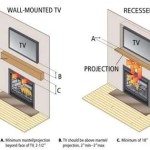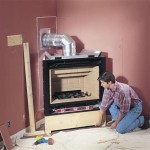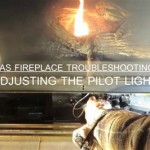Two-Sided Fireplace Designs: An Architectural Centerpiece
Two-sided fireplaces, also known as see-through fireplaces, offer a unique method of dividing spaces while simultaneously enhancing both areas with the warmth and ambiance of a fire. These fireplaces are not merely functional heating elements; they are architectural features that can significantly impact the aesthetic and flow of a home. Their design promotes connectivity, allowing light and heat to permeate adjacent rooms, fostering a sense of openness and shared comfort. This article will explore the various aspects of two-sided fireplace designs, including their benefits, design considerations, and the types of applications where they excel.
The appeal of a two-sided fireplace lies in its ability to create a focal point that is visible from multiple locations within a living space. Unlike a traditional fireplace that is typically positioned against a single wall, a two-sided fireplace can act as a transparent barrier, subtly defining different zones within an open-concept layout. This is particularly advantageous in modern homes where large, open spaces are prevalent.
Maximizing Spatial Division and Visual Appeal
One of the key advantages of a two-sided fireplace is its capacity to delineate space without compromising the feeling of openness. In an open-plan living room and dining room, for example, a two-sided fireplace can serve as a visual divider, subtly separating the two areas while still allowing for easy interaction and a continuous flow of light. This creates distinct zones for different activities, enhancing the functionality of the space. The fireplace acts as a shared element, tying the rooms together aesthetically and functionally.
Beyond spatial division, a two-sided fireplace offers enhanced visual appeal by being visible from different angles. This allows for multiple seating arrangements and perspectives from which to enjoy the fire. The flickering flames become a dynamic feature that adds warmth and character to both rooms. Furthermore, the fireplace surround can be designed to complement the style of both spaces, creating a cohesive design element that unifies the overall aesthetic.
The location of a two-sided fireplace greatly influences its impact. Placement in a central location, such as between a living room and a kitchen, allows for maximum visibility and distribution of heat. Alternatively, positioning it between a master bedroom and an ensuite bathroom can create a luxurious and spa-like atmosphere. The design possibilities are extensive and can be tailored to the specific needs and preferences of the homeowner.
Design Considerations for Two-Sided Fireplaces
Designing a two-sided fireplace requires careful consideration of several key factors to ensure optimal functionality, safety, and aesthetic integration. These considerations include the type of fireplace (gas, wood-burning, or electric), ventilation requirements, structural support, and the choice of materials for the fireplace surround.
The choice of fireplace type is crucial. Gas fireplaces offer convenience and ease of use, with readily adjustable flame height and heat output. They also typically require less maintenance than wood-burning fireplaces. Wood-burning fireplaces, on the other hand, provide a more traditional and rustic aesthetic, along with the crackling sound and aroma of burning wood. However, they require proper ventilation and a dedicated chimney. Electric fireplaces are the most versatile option, as they do not require venting and can be easily installed in almost any location. They offer a realistic flame effect and adjustable heat output, making them a popular choice for modern homes.
Ventilation is a critical consideration, particularly for wood-burning and gas fireplaces. Proper ventilation is essential to ensure safe and efficient operation, preventing the buildup of harmful gases. Gas fireplaces typically require direct venting, while wood-burning fireplaces require a chimney. The placement and design of the ventilation system should be carefully planned to minimize impact on the aesthetic of the space.
Structural support is another important factor to consider, especially for larger two-sided fireplaces. The fireplace structure must be adequately supported to ensure stability and prevent any potential safety hazards. This may require reinforcement of the existing floor or wall structure. Consulting with a structural engineer is essential to ensure that the fireplace is properly supported.
The choice of materials for the fireplace surround plays a significant role in the overall aesthetic. Common materials include stone, brick, tile, and metal. The choice of material should complement the style of both rooms and create a cohesive design element. The surround should also be fire-resistant and durable to withstand the heat generated by the fireplace.
Applications of Two-Sided Fireplaces in Residential Design
Two-sided fireplaces find applications in a variety of residential settings, offering unique solutions for space division and aesthetic enhancement. They are particularly well-suited for open-concept homes, master suites, and outdoor living spaces. Their versatility allows them to be incorporated into a wide range of architectural styles, from traditional to contemporary.
In open-concept homes, a two-sided fireplace can effectively separate the living room from the dining room or kitchen, creating distinct zones for different activities. This allows for a more organized and functional living space without sacrificing the feeling of openness. The fireplace acts as a central gathering point, fostering a sense of connection and shared comfort.
In master suites, a two-sided fireplace can create a luxurious and romantic atmosphere by dividing the sleeping area from the bathroom or dressing area. The fireplace provides warmth and ambiance to both spaces, enhancing the overall sense of relaxation and comfort. The flames become a focal point, creating a tranquil and inviting environment.
Outdoor living spaces can also benefit from the addition of a two-sided fireplace. It can divide a patio from a garden or lawn, creating a defined outdoor living area. This allows for year-round enjoyment of the outdoors, providing warmth and ambiance on cool evenings. The fireplace can also serve as a cooking element, adding functionality to the outdoor space.
Beyond these specific applications, two-sided fireplaces can also be used in other areas of the home, such as between a study and a hallway, or between a sunroom and a living room. The possibilities are endless and can be tailored to the specific needs and preferences of the homeowner.
The integration of a two-sided fireplace into a home's design is often a collaborative process involving architects, interior designers, and contractors. Careful planning and coordination are essential to ensure that the fireplace is properly installed, ventilated, and structurally supported. The design should also be aesthetically pleasing and complementary to the overall style of the home.
Ultimately, the success of a two-sided fireplace design lies in its ability to seamlessly integrate functionality, aesthetics, and safety. By carefully considering the various factors involved, homeowners can create a stunning architectural centerpiece that enhances the beauty and comfort of their living space.
The advancements in fireplace technology have also contributed to the increasing popularity of two-sided fireplaces. Modern gas and electric fireplaces offer enhanced safety features, energy efficiency, and realistic flame effects, making them an attractive option for homeowners. Furthermore, the availability of a wide range of designs and materials allows for greater customization and personalization.
Proper maintenance is crucial for ensuring the longevity and safety of a two-sided fireplace. Regular cleaning and inspection are essential to prevent the buildup of soot, debris, and other obstructions that can affect its performance. It is also important to have the fireplace professionally inspected annually to ensure that all components are functioning properly and safely.
In conclusion, two-sided fireplaces are a versatile and aesthetically pleasing design element that can significantly enhance the functionality and beauty of a home. Their ability to divide spaces while simultaneously providing warmth and ambiance makes them a valuable addition to any residential setting. By carefully considering the various design considerations and selecting the appropriate type of fireplace, homeowners can create a stunning architectural centerpiece that will be enjoyed for years to come.

Double Sided Fireplace Design Ideas
:strip_icc()/101878383-94197133bc5c4d6ab40663768b12d3af.jpg?strip=all)
Two Sided Fireplaces
:strip_icc()/101650552-e405da465bcf430c8a00a965d349be86.jpg?strip=all)
Two Sided Fireplaces

Double Sided Fireplace Design Ideas

Before And After 1980 S Split Level House Transformation In Home Design Lover Double Sided Fireplace Small Modern Living Room

40 Double Sided Fireplaces With Pros And Cons Digsdigs

These 15 Double Sided Fireplaces Wishing For The Coldest Nights Of Year

Double Sided Fireplaces Two Sides Endless Benefits Luxurybedroomswithfireplace Fireplace Design Modern

Double Sided Fireplace Design Ideas

How Double Sided Fireplaces Give An Enhancement To Your Decor
Related Posts








